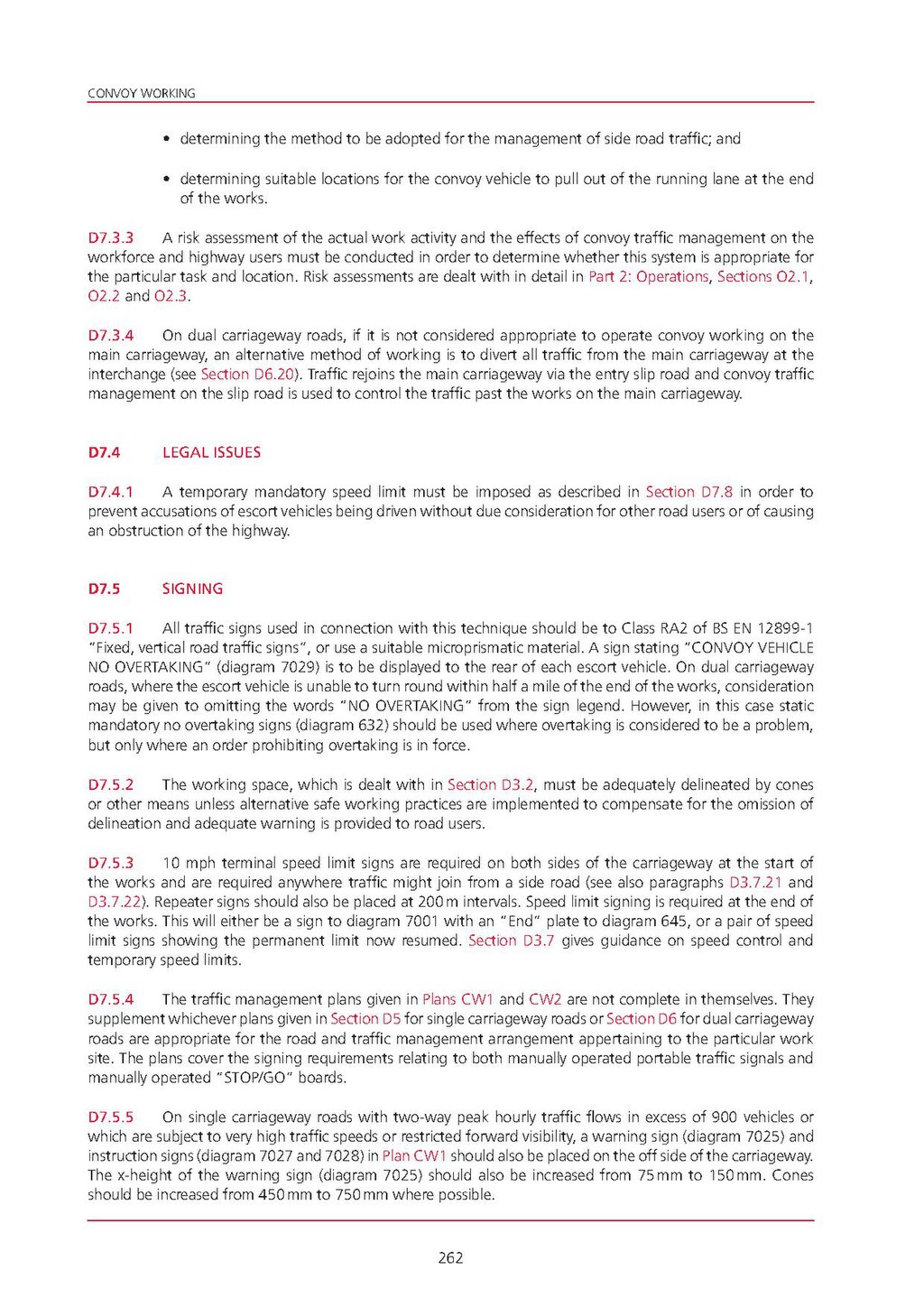- determining the method to be adopted for the management of side road traffic; and
- determining suitable locations for the convoy vehicle to pull out of the running lane at the end of the works.
D7.3.3 A risk assessment of the actual work activity and the effects of convoy traffic management on the workforce and highway users must be conducted in order to determine whether this system is appropriate for the particular task and location. Risk assessments are dealt with in detail in Part 2: Operations, Sections O2.1, O2.2 and O2.3.
D7.3.4 On dual carriageway roads, if it is not considered appropriate to operate convoy working on the main carriageway, an alternative method of working is to divert all traffic from the main carriageway at the interchange (see Section D6.20). Traffic rejoins the main carriageway via the entry slip road and convoy traffic management on the slip road is used to control the traffic past the works on the main carriageway.
D7.4LEGAL ISSUES
D7.4.1 A temporary mandatory speed limit must be imposed as described in Section D7.8 in order to prevent accusations of escort vehicles being driven without due consideration for other road users or of causing an obstruction of the highway.
D7.5SIGNING
D7.5.1 All traffic signs used in connection with this technique should be to Class RA2 of BS EN 12899-1 "Fixed, vertical road traffic signs", or use a suitable microprismatic material. A sign stating "CONVOY VEHICLE NO OVERTAKING" (diagram 7029) is to be displayed to the rear of each escort vehicle. On dual carriageway roads, where the escort vehicle is unable to turn round within half a mile of the end of the works, consideration may be given to omitting the words "NO OVERTAKING" from the sign legend. However, in this case static mandatory no overtaking signs (diagram 632) should be used where overtaking is considered to be a problem, but only where an order prohibiting overtaking is in force.
D7.5.2 The working space, which is dealt with in Section D3.2, must be adequately delineated by cones or other means unless alternative safe working practices are implemented to compensate for the omission of delineation and adequate warning is provided to road users.
D.7.5.3 10 mph terminal speed limit signs are required on both sides of the carriageway at the start of the works and are required anywhere traffic might join from a side road (see also paragraphs D3.7.21 and D3.7.22). Repeater signs should also be placed at 200m intervals. Speed limit signing is required at the end of the works. This will either be a sign to diagram 7001 with an "End" plate to diagram 645, or a pair of speed limit signs showing the permanent limit now resumed. Section D3.7.D3.7 gives guidance on speed control and temporary speed limits.
D7.5.4 The traffic management plans given in Plans CW1 and CW2 are not complete in themselves. They supplement whichever plans given in Section D5 for single carriageway roads or Section D6 for dual carriageway roads are appropriate for the road and traffic management arrangement appertaining to the particular work site. The plans cover the signing requirements relating to both manually operated portable traffic signals and manually operated "STOP/GO” boards.
D7.5.5 On single carriageway roads with two-way peak hourly traffic flows in excess of 900 vehicles or which are subject to very high traffic speeds or restricted forward visibility, a warning sign (diagram 7025) and instruction signs (diagram 7027 and 7028) in Plan CW1 should also be placed on the off side of the carriageway. The x-height of the warning sign (diagram 7025) should also be increased from 75mm to 150mm. Cones should be increased from 450mm to 750mm where possible.
262
